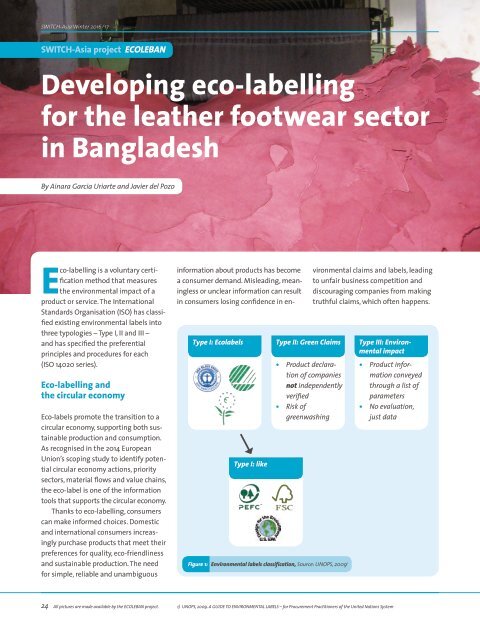SWITCH-Asia MAG Winter 2016/17 on Circular Economy. (c) SWITCH-Asia Network Facility. Design: Elmar Sander and Katharina Olma
Create successful ePaper yourself
Turn your PDF publications into a flip-book with our unique Google optimized e-Paper software.
<str<strong>on</strong>g>SWITCH</str<strong>on</strong>g>-<str<strong>on</strong>g>Asia</str<strong>on</strong>g> <str<strong>on</strong>g>Winter</str<strong>on</strong>g> <str<strong>on</strong>g>2016</str<strong>on</strong>g>/<str<strong>on</strong>g>17</str<strong>on</strong>g><br />
<str<strong>on</strong>g>SWITCH</str<strong>on</strong>g>-<str<strong>on</strong>g>Asia</str<strong>on</strong>g> project ECOLEBAN<br />
Developing eco-labelling<br />
for the leather footwear sector<br />
in Bangladesh<br />
By Ainara Garcia Uriarte <strong>and</strong> Javier del Pozo<br />
Eco-labelling is a voluntary certificati<strong>on</strong><br />
method that measures<br />
the envir<strong>on</strong>mental impact of a<br />
product or service. The Internati<strong>on</strong>al<br />
St<strong>and</strong>ards Organisati<strong>on</strong> (ISO) has classified<br />
existing envir<strong>on</strong>mental labels into<br />
three typologies – Type I, II <strong>and</strong> III –<br />
<strong>and</strong> has specified the preferential<br />
principles <strong>and</strong> procedures for each<br />
(ISO 14020 series).<br />
Eco-labelling <strong>and</strong><br />
the circular ec<strong>on</strong>omy<br />
Eco-labels promote the transiti<strong>on</strong> to a<br />
circular ec<strong>on</strong>omy, supporting both sustainable<br />
producti<strong>on</strong> <strong>and</strong> c<strong>on</strong>sumpti<strong>on</strong>.<br />
As recognised in the 2014 European<br />
Uni<strong>on</strong>’s scoping study to identify potential<br />
circular ec<strong>on</strong>omy acti<strong>on</strong>s, priority<br />
sectors, material flows <strong>and</strong> value chains,<br />
the eco-label is <strong>on</strong>e of the informati<strong>on</strong><br />
tools that supports the circular ec<strong>on</strong>omy.<br />
Thanks to eco-labelling, c<strong>on</strong>sumers<br />
can make informed choices. Domestic<br />
<strong>and</strong> internati<strong>on</strong>al c<strong>on</strong>sumers increasingly<br />
purchase products that meet their<br />
preferences for quality, eco-friendliness<br />
<strong>and</strong> sustainable producti<strong>on</strong>. The need<br />
for simple, reliable <strong>and</strong> unambiguous<br />
Type I: Ecolabels Type II: Green Claims Type III: Envir<strong>on</strong>mental<br />
impact<br />
Type I: like<br />
• Product declarati<strong>on</strong><br />
of companies<br />
not independently<br />
verified<br />
• Risk of<br />
greenwashing<br />
Figure 1: Envir<strong>on</strong>mental labels classificati<strong>on</strong>, Source: UNOPS, 2009 1<br />
informati<strong>on</strong> about products has become<br />
a c<strong>on</strong>sumer dem<strong>and</strong>. Misleading, meaningless<br />
or unclear informati<strong>on</strong> can result<br />
in c<strong>on</strong>sumers losing c<strong>on</strong>fidence in envir<strong>on</strong>mental<br />
claims <strong>and</strong> labels, leading<br />
to unfair business competiti<strong>on</strong> <strong>and</strong><br />
discouraging companies from making<br />
truthful claims, which often happens.<br />
• Product informati<strong>on</strong><br />
c<strong>on</strong>veyed<br />
through a list of<br />
parameters<br />
• No evaluati<strong>on</strong>,<br />
just data<br />
24<br />
All pictures are made available by the ECOLEBAN project.<br />
1) UNOPS, 2009. A GUIDE TO ENVIRONMENTAL LABELS – for Procurement Practiti<strong>on</strong>ers of the United Nati<strong>on</strong>s System


